Delayed Reproduction, Injury, and Regeneration of Testes in Out-of-Season Breeding of Largemouth Bass (Micropterus nigricans)
Abstract
1. Introduction
2. Materials and Methods
2.1. Experimental Protocol
2.2. Tissue Sampling
2.3. HE Staining
2.4. Transmission Electron Microscopy
2.5. Serum Hormone Determination
2.6. mRNA Expression Analysis
2.7. Western Blot
2.8. Statistical Analysis
3. Results
3.1. Average Weight, GSI, and HSI
3.2. Histopathological Evaluations
3.3. Electron Microscopic Examination
3.4. Expression Levels of Membrane-Related Genes
3.5. Determination of Hormone-Related Indices
3.6. Oxidative Stress Parameters Assays
3.7. Measurement of Apoptosis-Related Indices
4. Discussion
4.1. Delayed Sperm Discharge and Sperm Regeneration of Largemouth Bass during Out-of-Season Breeding
4.2. Histological Damage to Testis during Out-of-Season Breeding
4.3. Apoptosis in Spermatozoa during Out-of-Season Breeding
4.4. Oxidative Stress in the Testis during Out-of-Season Breeding
5. Conclusions
Supplementary Materials
Author Contributions
Funding
Institutional Review Board Statement
Informed Consent Statement
Data Availability Statement
Acknowledgments
Conflicts of Interest
References
- Barrett, T.J.; Rossong, M.A.; van den Heuvel, M.R.; Munkittrick, K.R. Assessing reproductive effects on fish populations: An evaluation of methods to predict the reproductive strategy of fishes. Environ. Monit. Assess. 2020, 192, 613. [Google Scholar] [CrossRef] [PubMed]
- Hussein, G.H.G.; Chen, M.; Qi, P.P.; Cui, Q.K.; Yu, Y.; Hu, W.H.; Tian, Y.; Fan, Q.X.; Gao, Z.X.; Feng, M.W.; et al. Aquaculture industry development, annual price analysis and out-of-season spawning in largemouth bass. Aquaculture 2020, 519, 734901. [Google Scholar] [CrossRef]
- Zhao, L.L.; Xiong, C.; Yang, Y.; Li, Z.H.; He, K.; Liu, Q.; He, Z.; Luo, J.; Zhang, X.; Li, Z.Q.; et al. The protective effect of resveratrol on largemouth bass (Micropterus salmoides) during out-of-season spawning. Fish Shellfih Immun. 2023, 136, 108688. [Google Scholar] [CrossRef]
- Song, Y.; Zheng, W.W.; Zhang, M.Q.; Cheng, X.M.; Cheng, J.Y.; Wang, W.B.; Zhang, J.; Li, Y.Z. Out-of-season artificial reproduction techniques of cultured female tongue sole (Cynoglossus semilaevis): Broodstock management, administration methods of hormone therapy and artificial fertilization. Aquaculture 2020, 518, 734866. [Google Scholar] [CrossRef]
- Rahman, M.L.; Zahangir, M.M.; Kitahashi, T.; Shahjahan, M.; Ando, H. Effects of high and low temperature on expression of GnIH, GnIH receptor, GH and PRL genes in the male grass puffer during breeding season. Gen. Comp. Endocr. 2019, 282, 113200. [Google Scholar] [CrossRef] [PubMed]
- Figueroa, E.; Lee-Estevez, M.; Valdebenito, I.; Watanabe, I.; Oliveira, R.P.S.; Romero, J.; Castillo, R.L.; Farías, J.G. Effects of cryopreservation on mitochondrial function and sperm quality in fish. Aquaculture 2019, 511, 634190. [Google Scholar] [CrossRef]
- Melo, R.M.C.; Ribeiro, Y.M.; Luz, R.K.; Bazzoli, N.; Rizzo, E. Influence of low temperature on structure and dynamics of spermatogenesis during culture of Oreochromis niloticus. Anim. Reprod. Sci. 2016, 172, 148–156. [Google Scholar] [CrossRef]
- Zohar, Y.; Muñoz-Cueto, J.A.; Elizur, A.; Kah, O. Neuroendocrinology of reproduction in teleost fish. Gen. Comp. Endocr. 2010, 165, 438–455. [Google Scholar] [CrossRef]
- Alfonso, S.; Houdelet, C.; Bessa, E.; Geffroy, B.; Sadoul, B. Water temperature explains part of the variation in basal plasma cortisol level within and between fish species. J. Fish Biol. 2023, 103, 828–838. [Google Scholar] [CrossRef]
- Sandoval-Vargas, L.; Jiménez, M.S.; González, J.R.; Villalobos, E.F.; Cabrita, E.; Isler, I.V. Oxidative stress and use of antioxidants in fish semen cryopreservation. Rev. Aquac. 2021, 13, 365–387. [Google Scholar] [CrossRef]
- Liu, W.; Vetreno, R.P.; Crews, F.T. Hippocampal TNF-death receptors, caspase cell death cascades, and IL-8 in alcohol use disorder. Mol. Psychiatr. 2021, 26, 2254–2262. [Google Scholar] [CrossRef] [PubMed]
- Oliver, L.P.; Evavold, J.T.; Cain, K.D. Out-of-season spawning of burbot (Lota lota) through temperature and photoperiod manipulation. Aquaculture 2021, 543, 736917. [Google Scholar] [CrossRef]
- Qiang, J.; Tao, Y.F.; Zhu, J.H.; Lu, S.Q.; Cao, Z.M.; Ma, J.L.; He, J.; Xu, P. Effects of heat stress on follicular development and atresia in Nile tilapia (Oreochromis niloticus) during one reproductive cycle and its potential regulation by autophagy and apoptosis. Aquaculture 2022, 555, 738171. [Google Scholar] [CrossRef]
- Grier, H.J.; Porak, W.F.; Carroll, J.; Parenti, L.R. Oocyte Development and Staging in the Florida Bass, Micropterus floridanus (LeSueur, 1822), with Comments on the Evolution of Pelagic and Demersal Eggs in Bony Fishes. Copeia 2018, 106, 329–345. [Google Scholar] [CrossRef]
- Matthews, M.D.; Stout, R.B. Out-of-Season Spawning Method for Florida Largemouth Bass to Produce Advanced-Sized Fingerlings by Early Spring. N. Am. J. Aquac. 2013, 75, 524–531. [Google Scholar] [CrossRef]
- Nagahama, Y.; Yoshikuni, M.; Yamashita, M.; Tokumoto, T.; Katsu, Y. 4 Regulation of oocyte growth and maturation in fish. Curr. Top. Dev. Biol. 1995, 30, 103–145. [Google Scholar] [PubMed]
- Andersson, A.-M.; Müller, J.; Skakkebæk, N.E. Different roles of prepubertal and postpubertal germ cells and Sertoli cells in the regulation of serum inhibin B levels. J. Clin. Endocrinol. Metab. 1998, 83, 4451–4458. [Google Scholar] [CrossRef] [PubMed]
- Grinspon, R.P.; Rey, R.A. Anti-Mullerian Hormone and Sertoli Cell Function in Paediatric Male Hypogonadism. Horm. Res. Paediatr. 2010, 73, 81–92. [Google Scholar] [CrossRef]
- Liu, Y.F.; Liu, Q.H.; Xu, S.H.; Wang, Y.F.; Feng, C.C.; Zhao, C.Y.; Song, Z.C.; Li, J. A Deep Insight of Spermatogenesis and Hormone Levels of Aqua-Cultured Turbot (Scophthalmus maximus). Front. Mar. Sci. 2021, 7, 592880. [Google Scholar] [CrossRef]
- Morini, M.; Peñaranda, D.S.; Vílchez, M.C.; Tveiten, H.; Lafont, A.G.; Dufour, S.; Pérez, L.; Asturiano, J.F. The expression of nuclear and membrane estrogen receptors in the European eel throughout spermatogenesis. Comp. Biochem. Phys. A 2017, 203, 91–99. [Google Scholar] [CrossRef]
- Liu, C.; Ding, J.; Gao, X.M.; Du, C.; Hou, C.C.; Wu, X.F.; Shen, W.L.; Zhu, J.Q. Effects of acute low temperature stress on the hormones and gene expression of glucocorticoid receptor of large yellow croaker Larimichthys crocea. J. Therm. Biol. 2021, 99, 103018. [Google Scholar] [CrossRef] [PubMed]
- Holland, M.C.; Hassin, S.; Zohar, Y. Gonadal development and plasma steroid levels during pubertal development in captive-reared striped bass, Morone saxatilis. J. Exp. Zool. 2000, 286, 49–63. [Google Scholar] [CrossRef]
- Ottesen, O.H.; Marschhäuser, V.; Babiak, I. Effects of Cryopreservation on Morphology and Viability of Sperm and Larvae of Atlantic Cod, Gadus morhua L. J. World Aquac. Soc. 2012, 43, 375–386. [Google Scholar] [CrossRef]
- Yao, Z.; Crim, L.; Richardson, G.F.; Emerson, C. Motility, fertility and ultrastructural changes of ocean pout (Macrozoarces americanus L.) sperm after cryopreservation. Aquaculture 2000, 181, 361–375. [Google Scholar] [CrossRef]
- Hammerstedt, R.H.; Graham, J.K.; Nolan, J.P. Cryopreservation of mammalian sperm: What we ask them to survive. J. Androl. 1990, 11, 73–88. [Google Scholar] [CrossRef]
- Parks, J.E.; Graham, J.K. Effects of cryopreservation procedures on sperm membranes. Theriogenology 1992, 38, 209–222. [Google Scholar] [CrossRef]
- Henkel, R.; Miiller, C.; Miska, W.; Gips, H.; Schill, W.-B. Fertilization and early embryology: Determination of the acrosome reaction in human spermatozoa is predictive of fertilization in vitro. Human Reprod. 1993, 8, 2128–2132. [Google Scholar] [CrossRef] [PubMed]
- Maksimov, E.G.; Mironov, K.S.; Trofimova, M.S.; Nechaeva, N.L.; Todorenko, D.A.; Klementiev, K.E.; Tsoraev, G.V.; Tyutyaev, E.V.; Zorina, A.A.; Feduraev, P.V.; et al. Membrane fluidity controls redox-regulated cold stress responses in cyanobacteria. Photosynth. Res. 2017, 133, 215–223. [Google Scholar] [CrossRef]
- Pequeño, B.; Castaño, C.; Alvarez-Rodriguez, M.; Bóveda, P.; de la Blanca, M.G.M.; Toledano-Díaz, A.; Galarza, D.A.; Rodriguez-Martinez, H.; Martínez-Madrid, B.; Santiago-Moreno, J. Variation of existence and location of aquaporin 3 in relation to cryoresistance of ram spermatozoa. Front. Vet. Sci. 2023, 10, 1167832. [Google Scholar] [CrossRef]
- Figueroa, E.; Farias, J.; Lee-Estevez, M.; Valdebenito, I.; Risopatrón, J.; Magnotti, C.; Romero, J.; Watanabe, I.; Oliveira, R.P.d.S. Sperm cryopreservation with supplementation of α-tocopherol and ascorbic acid in freezing media increase sperm function and fertility rate in Atlantic salmon (Salmo salar). Aquaculture 2018, 493, 1–8. [Google Scholar] [CrossRef]
- Bortner, C.D.; Cidlowski, J.A. A necessary role for cell shrinkage in apoptosis. Biochem. Pharmacol. 1998, 56, 1549–1559. [Google Scholar] [CrossRef]
- Zamaraev, A.V.; Kopeina, G.S.; Prokhorova, E.A.; Zhivotovsky, B.; Lavrik, I.N. Post-translational Modification of Caspases: The Other Side of Apoptosis Regulation. Trends Cell Biol. 2017, 27, 322–339. [Google Scholar] [CrossRef] [PubMed]
- Elmore, S. Apoptosis: A review of programmed cell death. Toxicol. Pathol. 2007, 35, 495–516. [Google Scholar] [CrossRef] [PubMed]
- Zhu, Q.H.; Zhang, L.L.; Li, L.; Que, H.Y.; Zhang, G.F. Expression Characterization of Stress Genes Under High and Low Temperature Stresses in the Pacific Oyster, Crassostrea gigas. Mar. Biotechnol. 2016, 18, 176–188. [Google Scholar] [CrossRef]
- Liu, R.; Liu, R.Y.; Song, G.L.; Li, Q.; Cui, Z.B.; Long, Y. Mitochondria Dysfunction and Cell Apoptosis Limit Resistance of Nile Tilapia (Oreochromis niloticus) to Lethal Cold Stress. Anim. 2022, 12, 2382. [Google Scholar] [CrossRef] [PubMed]
- Korsmeyer, S.; Wei, M.; Saito, M.; Weiler, S.; Oh, K.; Schlesinger, P. Pro-apoptotic cascade activates BID, which oligomerizes BAK or BAX into pores that result in the release of cytochrome c. Cell Death Differ. 2000, 7, 1166–1173. [Google Scholar] [CrossRef] [PubMed]
- Liu, T.F.; Wang, L.L.; Chen, H.; Huang, Y.F.; Yang, P.; Ahmed, N.; Wang, T.Z.; Liu, Y.; Chen, Q.S. Molecular and Cellular Mechanisms of Apoptosis during Dissociated Spermatogenesis. Front. Physiol. 2017, 8, 188. [Google Scholar] [CrossRef] [PubMed]
- Xu, Y.R.; Dong, H.S.; Yang, W.X. Regulators in the apoptotic pathway during. spermatogenesis: Killers or guards? Gene 2016, 582, 97–111. [Google Scholar] [CrossRef] [PubMed]
- Cheng, C.H.; Yang, F.F.; Liao, S.A.; Miao, Y.T.; Ye, C.X.; Wang, A.L.; Tan, J.W.; Chen, X.Y. High temperature induces apoptosis and oxidative stress in pufferfish (Takifugu obscurus) blood cells. J. Therm. Biol. 2015, 53, 172–179. [Google Scholar] [CrossRef] [PubMed]
- Ibarz, A.; Martín-Pérez, M.; Blasco, J.; Bellido, D.; de Oliveira, E.; Fernández-Borrás, J. Gilthead sea bream liver proteome altered at low temperatures by oxidative stress. Proteomics 2010, 10, 963–975. [Google Scholar] [CrossRef]
- Qi, Z.H.; Liu, Y.F.; Luo, S.W.; Chen, C.X.; Liu, Y.; Wang, W.N. Molecular cloning, characterization and expression analysis of tumor suppressor protein p53 from orange-spotted grouper, Epinephelus coioides in response to temperature stress. Fish Shellfish Immun. 2013, 35, 1466–1476. [Google Scholar] [CrossRef]
- Wu, S.M.; Liu, J.H.; Shu, L.H.; Chen, C.H. Anti-oxidative responses of zebrafish (Danio rerio) gill, liver and brain tissues upon acute cold shock. Comp. Biochem. Phys. A 2015, 187, 202–213. [Google Scholar] [CrossRef] [PubMed]
- Roy, A.; Sil, P.C. Taurine protects murine hepatocytes against oxidative stress-induced apoptosis by butyl hydroperoxide via PI3K/Akt and mitochondrial-dependent pathways. Food Chem. 2012, 131, 1086–1096. [Google Scholar] [CrossRef]
- Tolomeo, A.M.; Carraro, A.; Bakiu, R.; Toppo, S.; Place, S.P.; Ferro, D.; Santovito, G. Peroxiredoxin 6 from the Antarctic emerald rockcod: Molecular characterization of its response to warming. J. Comp. Physiol. B 2016, 186, 59–71. [Google Scholar] [CrossRef] [PubMed]
- Chang, C.H.; Wang, Y.C.; Lee, T.H. Hypothermal stress-induced salinity-dependent oxidative stress and apoptosis in the livers of euryhaline milkfish, Chanos Chanos. Aquaculture 2021, 534, 736280. [Google Scholar] [CrossRef]
- Alfredo, S.I.C.; Perla, M. Canonical and non-canonical mechanisms of Nrf2 activation. Pharmacol. Res. 2018, 134, 92–99. [Google Scholar]
- Zhang, Y.; Wang, G.Y.; Wang, T.R.; Cao, W.; Zhang, L.X.; Chen, X.Y. Nrf2-Keap1 pathway-mediated effects of resveratrol on oxidative stress and apoptosis in hydrogen peroxide-treated rheumatoid arthritis fibroblast-like synoviocytes. Ann. N. Y. Acad. Sci. 2019, 1457, 166–178. [Google Scholar] [CrossRef]
- Xu, Y.P.; Zheng, G.W.; Dong, S.Z.; Liu, G.F.; Yu, X.P. Molecular cloning, characterization and expression analysis of HSP60, HSP70 and HSP90 in the golden apple snail, Pomacea canaliculata. Fish Shellfish Immun. 2014, 41, 643–653. [Google Scholar] [CrossRef]
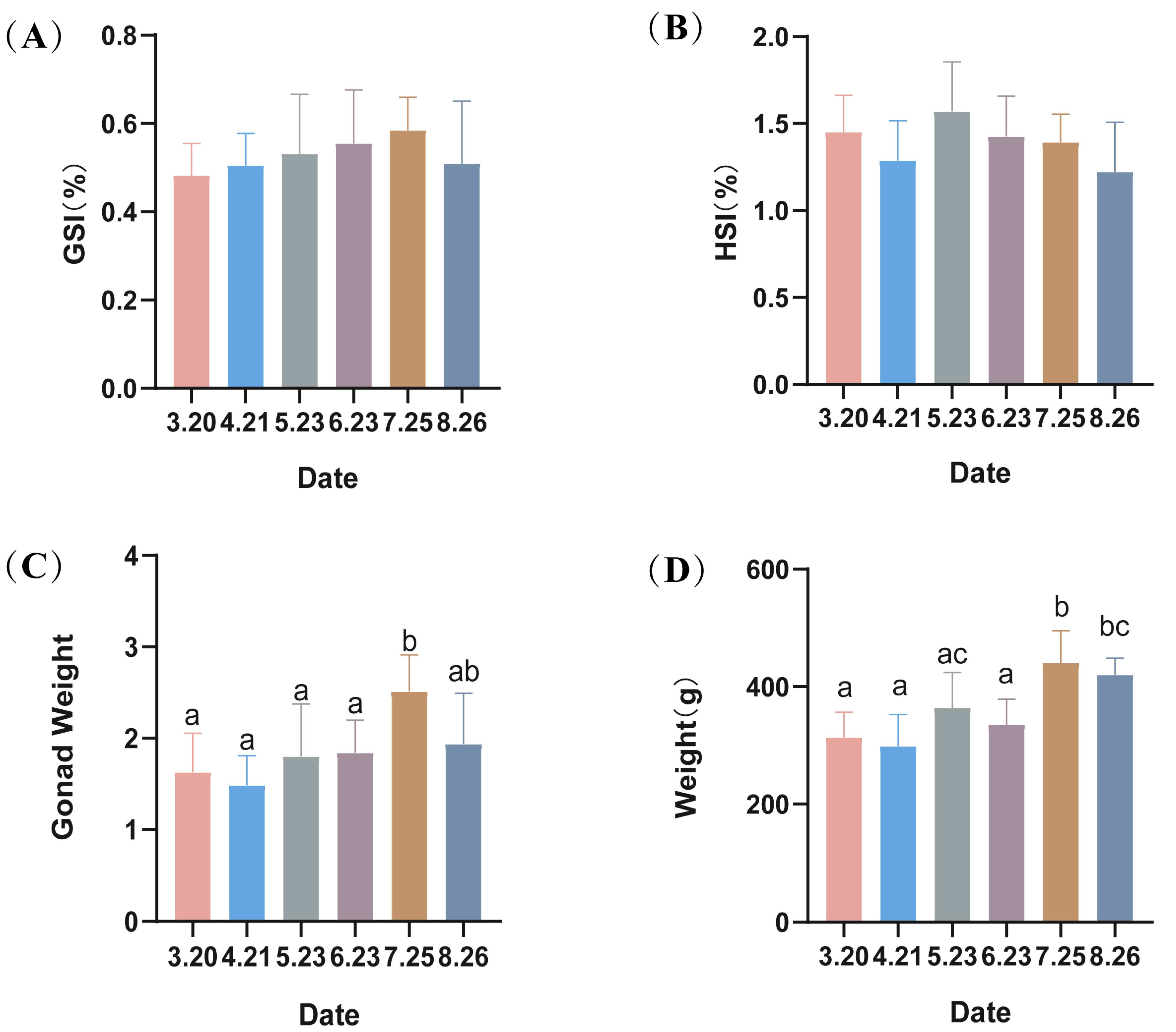

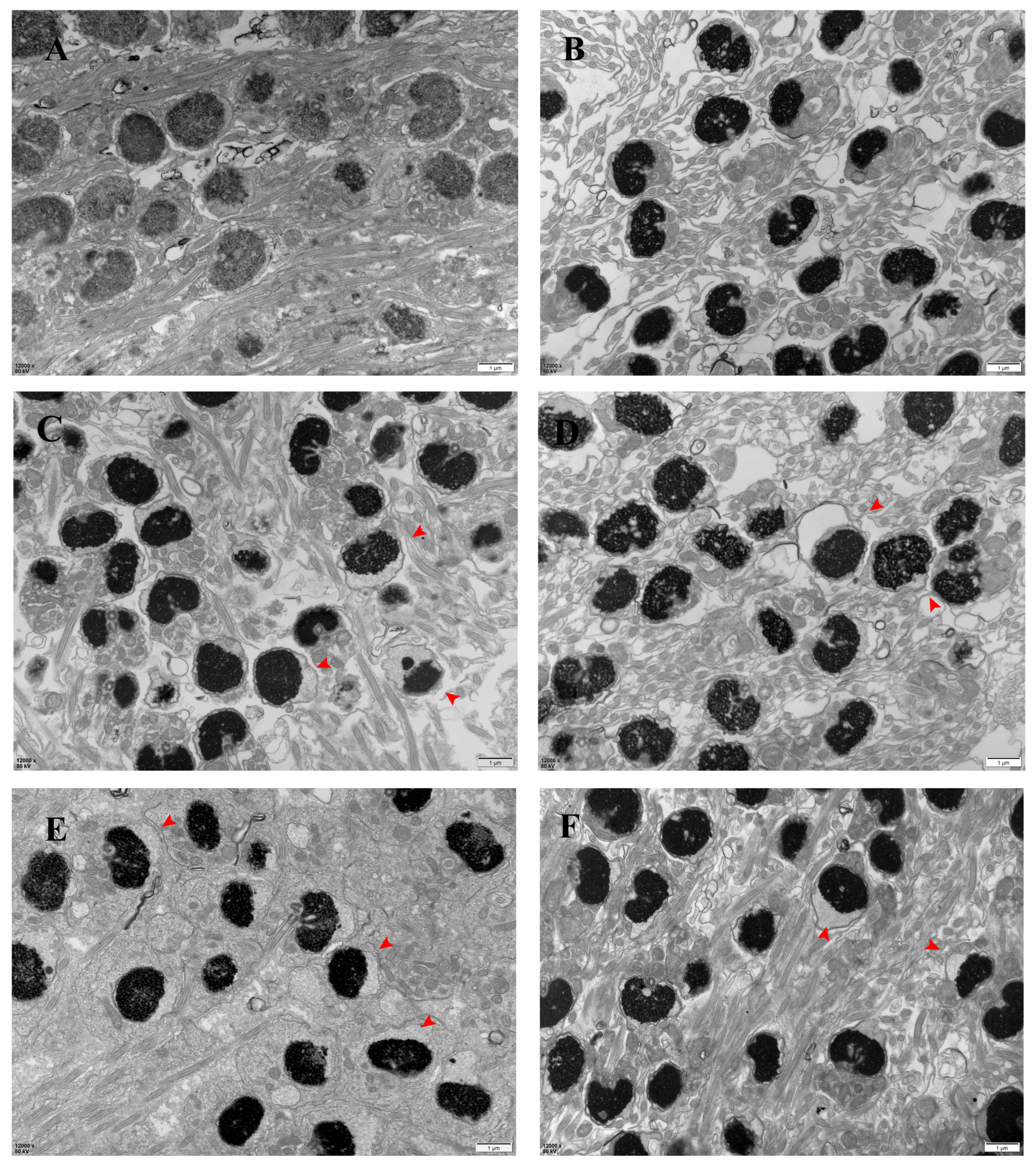


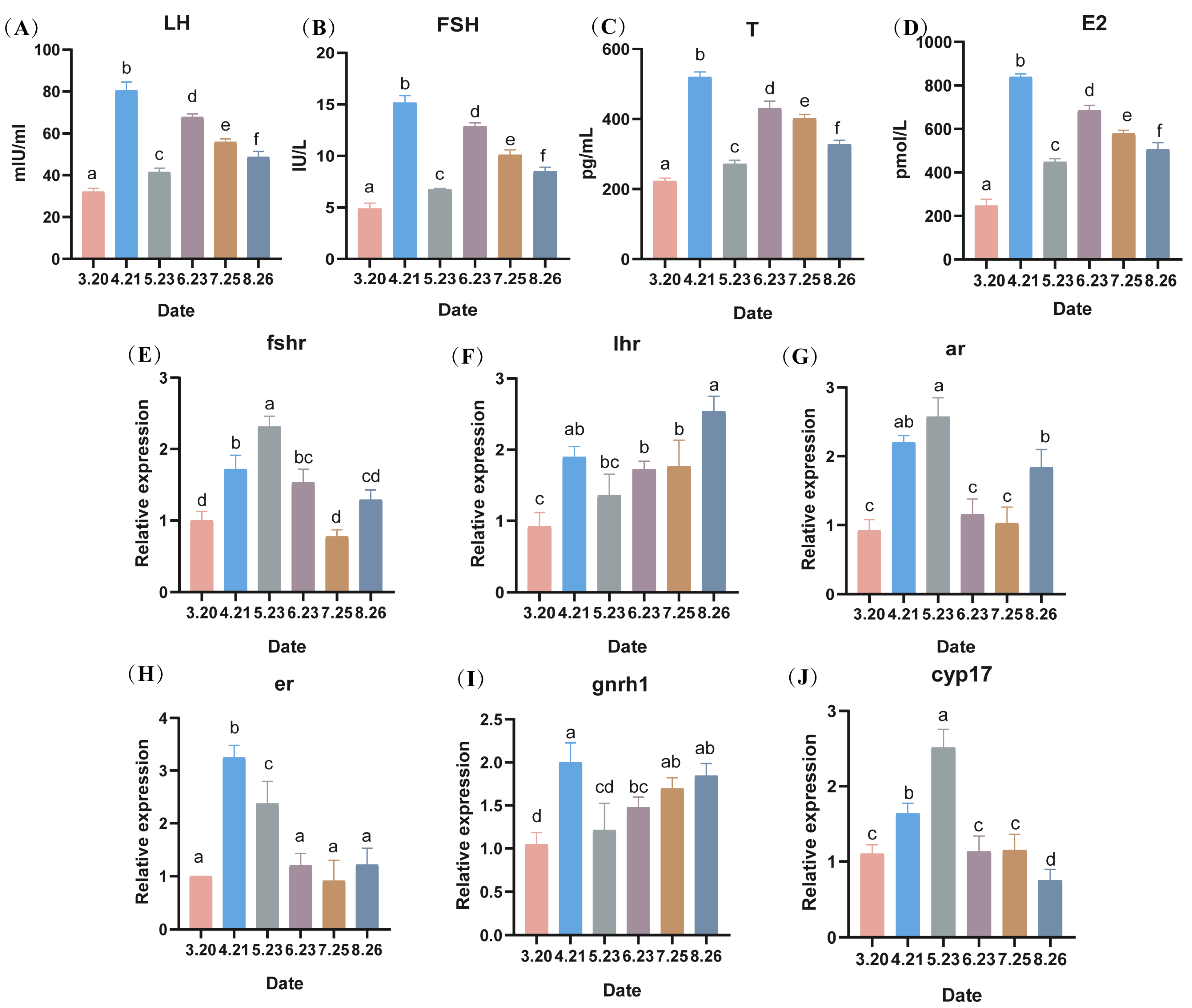
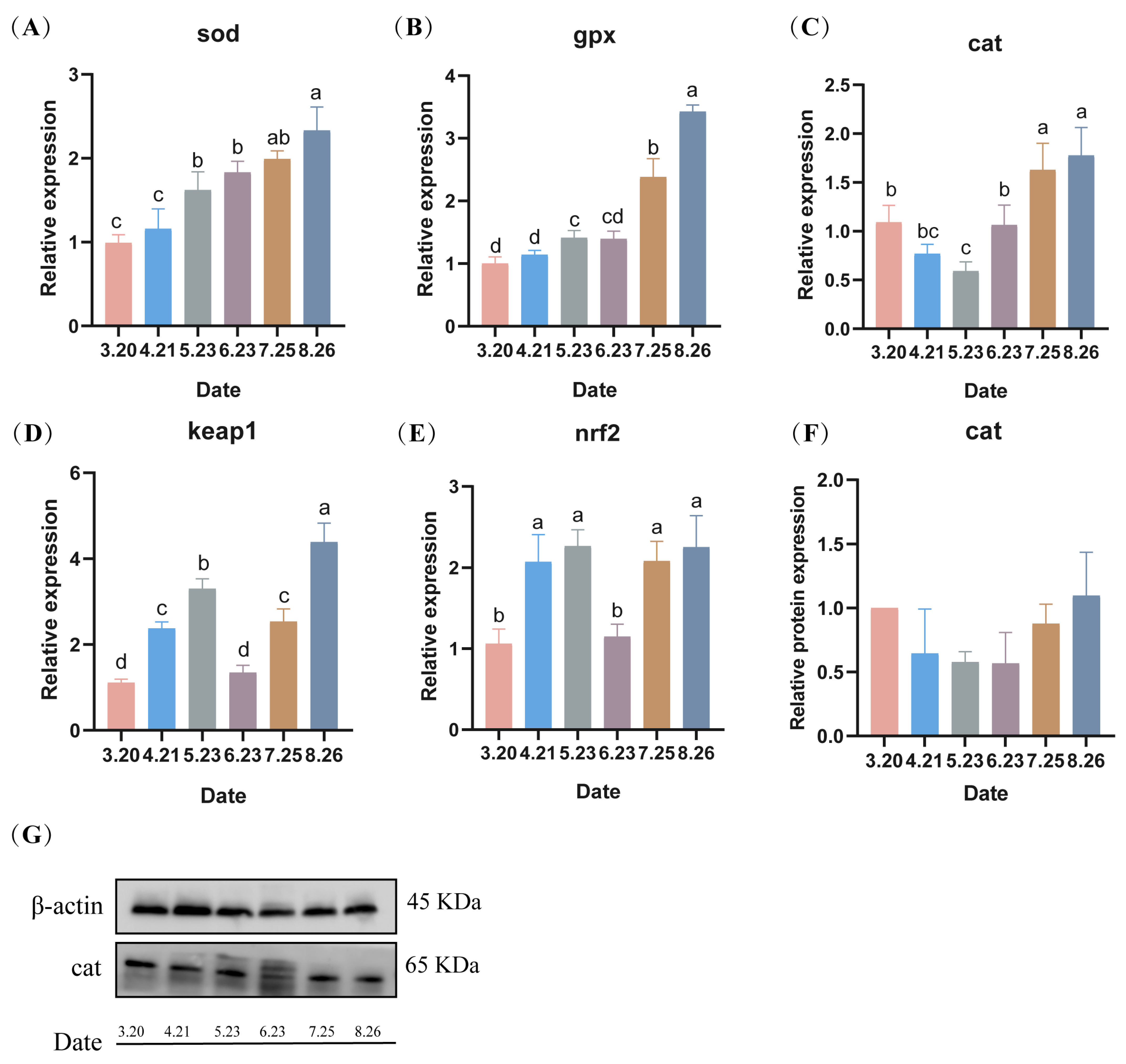
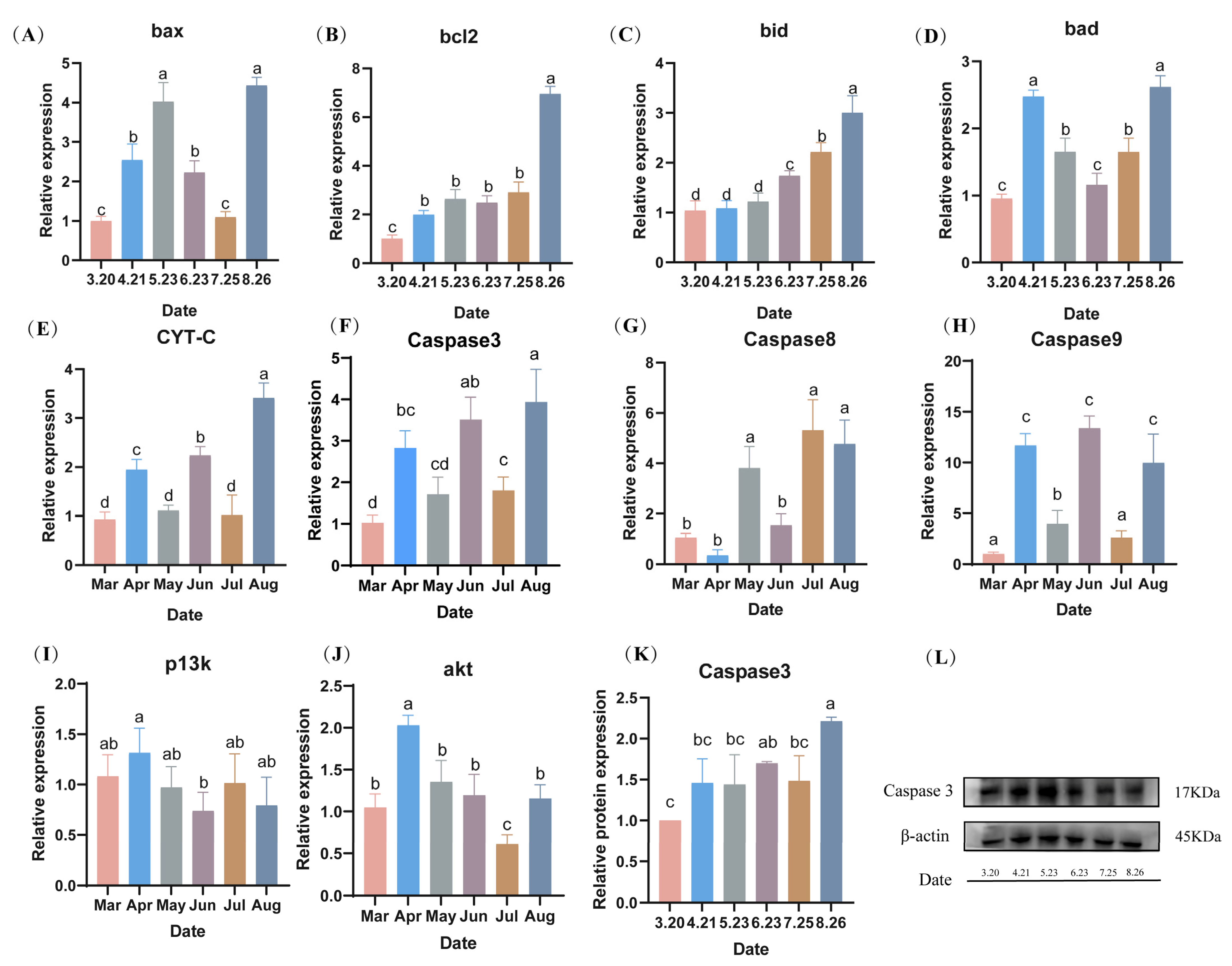
Disclaimer/Publisher’s Note: The statements, opinions and data contained in all publications are solely those of the individual author(s) and contributor(s) and not of MDPI and/or the editor(s). MDPI and/or the editor(s) disclaim responsibility for any injury to people or property resulting from any ideas, methods, instructions or products referred to in the content. |
© 2024 by the authors. Licensee MDPI, Basel, Switzerland. This article is an open access article distributed under the terms and conditions of the Creative Commons Attribution (CC BY) license (https://creativecommons.org/licenses/by/4.0/).
Share and Cite
He, K.; Yang, Y.; Li, Z.; Yan, H.; Song, K.; Liu, Q.; Zhao, L.; Yang, S. Delayed Reproduction, Injury, and Regeneration of Testes in Out-of-Season Breeding of Largemouth Bass (Micropterus nigricans). Antioxidants 2024, 13, 1077. https://doi.org/10.3390/antiox13091077
He K, Yang Y, Li Z, Yan H, Song K, Liu Q, Zhao L, Yang S. Delayed Reproduction, Injury, and Regeneration of Testes in Out-of-Season Breeding of Largemouth Bass (Micropterus nigricans). Antioxidants. 2024; 13(9):1077. https://doi.org/10.3390/antiox13091077
Chicago/Turabian StyleHe, Kuo, Yi Yang, Zhihong Li, Haoxiao Yan, Kaige Song, Qiao Liu, Liulan Zhao, and Song Yang. 2024. "Delayed Reproduction, Injury, and Regeneration of Testes in Out-of-Season Breeding of Largemouth Bass (Micropterus nigricans)" Antioxidants 13, no. 9: 1077. https://doi.org/10.3390/antiox13091077
APA StyleHe, K., Yang, Y., Li, Z., Yan, H., Song, K., Liu, Q., Zhao, L., & Yang, S. (2024). Delayed Reproduction, Injury, and Regeneration of Testes in Out-of-Season Breeding of Largemouth Bass (Micropterus nigricans). Antioxidants, 13(9), 1077. https://doi.org/10.3390/antiox13091077





